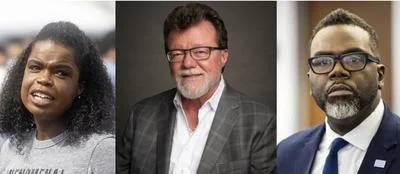Jason Johnson, president of the Washington D.C.-based Law Enforcement Legal Defense Fund | policedefense.org
Jason Johnson, president of the Washington D.C.-based Law Enforcement Legal Defense Fund | policedefense.org
A recently published pie chart breaking down crime according to race undermines the recurring narrative in the media that Chicago police unfairly target Blacks.
A website that compiles Chicago crime statistics, HeyJackass.com, posted a 2024 pie chart for Chicago showing that Blacks account for 77.9 percent of the victim/assailant category in the chart, meaning that they are the victims of the vast majority of crime and also the perpetrators.
The narrative that police unfairly and disproportionately target Blacks continues to play out in the press.
A February 21 ABC Chicago story began with “it’s not a new problem for Black motorists in Chicago: Police targeting vehicles with Black drivers more often than white drivers, and recent data analyzed by the ABC7 I-Team shows little improvement has been made to correct this inequity.”
And last summer, a WTTW story of a report from the team overseeing court ordered reforms of the Chicago Police Department: “The 140-page report from the independent monitoring team, led by attorney Maggie Hickey, makes no conclusion as to whether Chicago Police officers were more likely to stop Black and Latino Chicagoans because of racial or ethnic bias. But it notes that Chicago Police Department leaders offered no ‘legitimate rationale’ for the racial disparity.”
But as previously reported in Chicago City Wire, the report showing that the Chicago Police were nine times more likely to stop Blacks than Whites over 2018 and 2019 presents an incomplete and potentially misleading profile of law enforcement practices in the city, according to Jason Johnson, president of the Washington D.C.-based Law Enforcement Legal Defense Fund.
The report, by the team overseeing the court-ordered reforms of the Chicago Police Department (CPD)— just as reports of other police departments under consent decrees— fails to take into account additional critical variables, including the crime victims, Johnson said.
“What these reports don’t consider is that police are going to target their efforts in higher crime areas,” Johnson, who as deputy police commissioner in Baltimore implemented the city’s consent decree from 2016-2018, told Chicago City Wire. “So you really have to look at where the crimes are occurring and who the victims are.”
The racism narrative, notes Heather Mc Donald of City Journal, threatens public safety.
“Public safety has been destroyed in many American cities because of an idea,” Mac Donald wrote in a November article. “That idea holds that any law-enforcement activity that has a disparate impact on Black criminals is racist. Disparate impact is why many police departments have dismantled gang databases and antigun task forces, why they have given up on public-order enforcement, and why they have all but eliminated car stops.”
She continued: “It is why ‘progressive’ district attorneys have stopped prosecuting trespassing, shoplifting, fare evasion, and resisting arrest, why bail is being eliminated, and why judges let repeat offenders back on the street. Disparate impact is the reason that chain stores like Starbucks and Walgreens would rather close high-loss outlets than accost thieves.”






 Alerts Sign-up
Alerts Sign-up